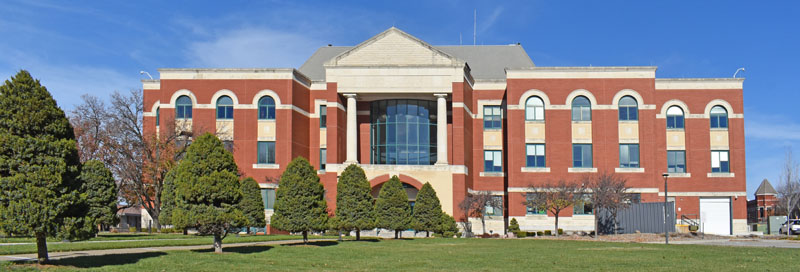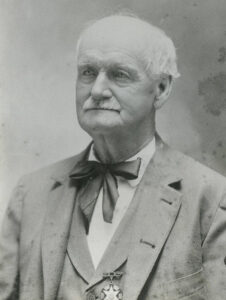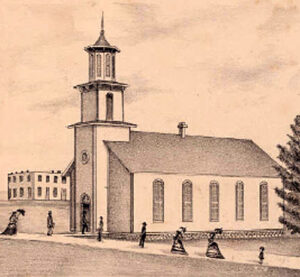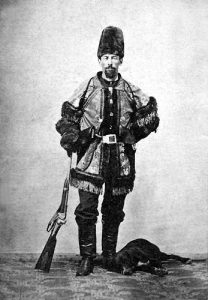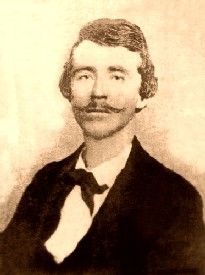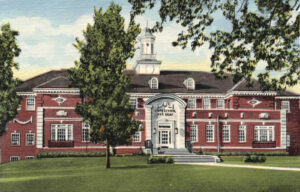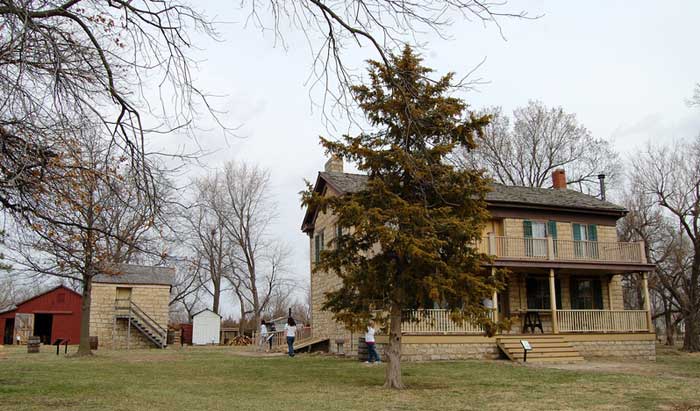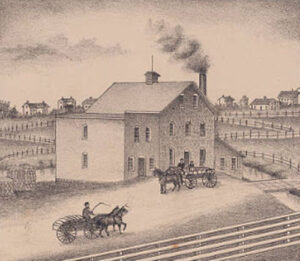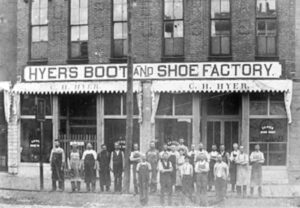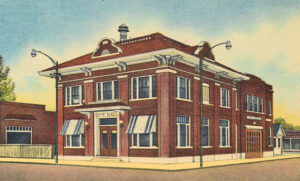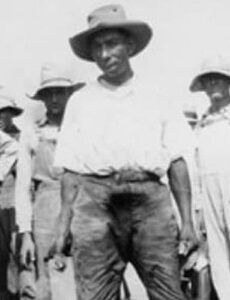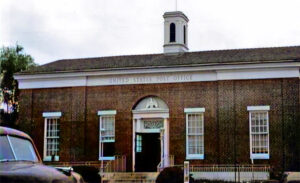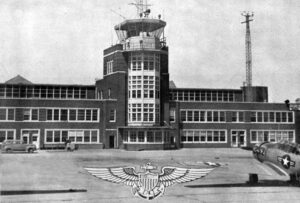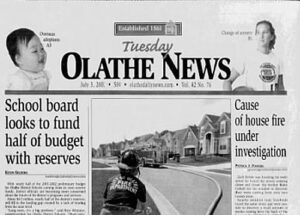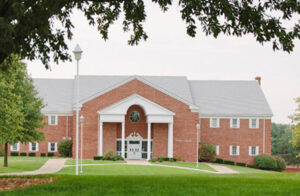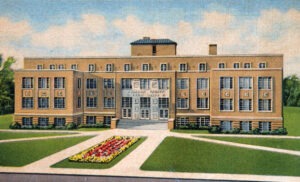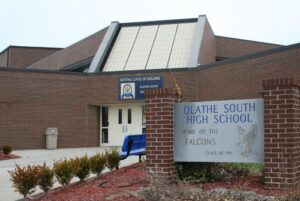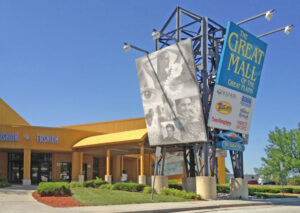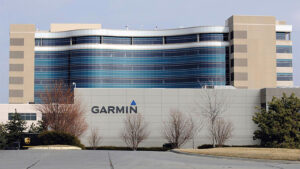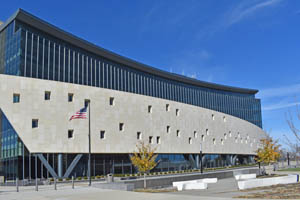Olathe, Kansas, the county seat of Johnson County, is located very near the county’s geographical center.
In the spring of 1857, the survey of the Shawnee Indian lands was followed closely by land speculators, among whom was Dr. John T. Barton. Riding to the center of Johnson County, Barton staked two-quarter sections of land as a townsite. Carpeted with a profusion of wildflowers, the location impressed Doctor Barton as beautiful. With him was a Shawnee Indian named Dave Dougherty, who exclaimed “O-la-the,” the Indian word for beautiful, which was adopted for the name of the future city.
Dr. John Barton, a Virginia native and a Philadelphia, Pennsylvania Medical College graduate, had drifted west in 1850 and soon after secured an appointment as a physician to the Shawnee Indians.
Shortly after locating the site, Barton had it surveyed and platted. While it was being surveyed, he organized a town company consisting of himself, A.G. Boone, Charles A. Osgood, R.B. Finley, William Fisher, Jr., and Henry W. Jones. The town company was incorporated, with himself as president, by an act of the Territorial legislature.
Dr. Barton and Ed Nash opened an office to sell real estate and realized very handsome returns. Dr. Barton and Charles A. Osgood built the first building made of rough lumber hauled from the Kansas River, which was located on West Park Street. Measuring 12×14 feet, it served as a grocery, a drug store, a dry goods store, a saloon, and a hotel. When it was built, the hotel and saloon part of it did a rushing business, with as many as 100 to 200 people stopping there during the day, but the little hotel turned none away. When bedtime came, the night clerk would open the door and say: “Gentlemen, here is your bed; there is plenty of room out here on this prairie grass. Don’t crowd,” and with a kind “goodnight” he would return to his duties, while the traveler found his bed on the prairie and counted the stars until he drifted off. This hotel had a rough board counter where guests took meals. If a customer needed a little extra stimulant, there was a barrel of liquor right in the room, and a turn of the fixture would fill his cup.
Because the population in Olathe and Johnson County was predominantly pro-slavery, the town and county were spared any large part in the border war of 1856-1858.
The second building, which served as a residence, was constructed by Colonel Clarkson and Jacob Thuma. A second house was built by General Dick Taylor, a son of Zachary Taylor, President of the United States. Soon after this, several other buildings were erected. A post office opened on May 4, 1857, with John Barton as the postmaster.
Other early settlers were J.B. Whittier and Miss Emily L. Whittier, the first woman in the new town; John Polk Campbell, a cousin of Ex-President James K. Polk; S.F. Hill, Beattie Mahaffie, Charles Mayo, who had at one time been mayor of Boston, Massachusetts; Henderson Boggs, Martin Ott, Edwin Nash, Charles A. Osgood, and J. Henry Blake. Jonathan Milliken took a farm near Olathe, brought the first team of horses to the town, and built the first substantial house. He soon married the first woman who came to the place, Miss Whittier.
Olathe served as a stop on the Oregon, California, and the Santa Fe Trails. Catering to travelers was the primary source of income for local stores and businesses.
In the next few years, Barton energetically worked in the new town’s interests and successfully increased the population. He was a man of fine personal appearance, an accomplished physician, personally very popular, and a man who would attain more than ordinary local importance in any community.
Olathe was re-incorporated in February 1858 due to doubts that the initial incorporation was legal, as it had been approved by the “Bogus Legislature” in 1857. That year, the Methodist Episcopal church was organized in 1858 by Reverend William Hubert. The first pastor was Reverend John Robinson, who came in 1859. The first church was built about 1866. In the early 1880s, it had a membership of 550.
During the political events of 1858 and 1859, Dr. John Barton led the Pro-slavery or Democratic party in Johnson County. In 1858, he was elected county treasurer; in 1859, he was elected a delegate to the Wyandotte Constitutional Convention. Barton was one of the 20 delegates who refused to sign the constitution because it did not meet his pro-slavery views.
During this time, tensions rose across the nation over the issue of slavery, which led to numerous clashes between abolitionist settlers and the neighboring slave state, Missouri. These clashes further escalated and became a part of the more significant conflict known as Bleeding Kansas.
The Olathe Herald, the first newspaper in Johnson County, was first published on August 29, 1859. Olathe’s first board of trustees was elected on September 14, 1859, including Dr. J.T. Barton, A.J. Clemmans, Jonathan Milliken, L.S. Cornwell, and S.F. Hill. Olathe legally became the Johnson County Seat in October. That year, Colonel J.E. Hayes was awarded a contract for building the new county jail for $6,000. It remained a serviceable building until it was destroyed by fire in 1905.
During his practice as a physician, John Barton was a frequent visitor to the home of Judge S.E. Wilkerson, where he met the Judge’s daughter, Josephine Wilkerson. The pair soon became engaged to be married. However, in 1860, Dr. Barton left Olathe under mysterious circumstances. Two days before the wedding, Doctor Barton left Olathe for Westport, Missouri, ostensibly to get his wedding suit. Before he left, he conveyed to her by deed all his real estate in Johnson County, which was considerable. Barton never returned to Olathe, and Miss Wilkerson’s first intimation that Barton was gone and would not return was received from the man who delivered to her the deeds left by Barton. No explanation was ever given for the Doctor’s action until 30 years later when Barton disclosed to a friend the reason for his leaving, which involved no reflection on the woman in the case.
The Church of Christ was organized on April 16, 1860, by G. W. Hutchinson and Pardee Butler, Evangelists, with about 25 members. Most of the time, up to 1878, Elder William Gans conducted religious services. In 1872, there were 45 members. A very neat church building was erected on Park Street in 1869 at a cost of about $3,500, but in 1881, on account of the building of the Olathe & Kansas City Railroad close to the church, it was removed to the corner of Chestnut and Lulu Streets.
G.W. Hutchinson and Pardu Butter also organized the Christian church that year. By the early 1880s, their membership was 316. A Young Men’s Timothy Club of 40 and a Bible class of 97 were features of this church. In the early 1880s, its buildings and real estate were valued at $5,500.
In 1861, the Olathe Mirror was started by John Francis; the following year, W. H. McGowan began to print the Western Progress. By that time, the political complexion of the population had changed completely, and the city and county became overwhelmingly Republican. This led the people of the city and county to expect their full share of trouble from the armed bands known to be across the line, only ten miles distant.
Violence dissipated when Kansas entered the Union as a Free-State under the Wyandotte Constitution in January 1861. However, peace continued to elude Olathe for many years. After the Civil War erupted in April 1861, two-thirds of all adult males in Kansas served in the Union Army. Union officials and local military forces created a military post in Olathe that year.
In September 1861, Olathe received a visit from the notorious Jayhawker, Charles Jennison, and his band, who arrested L.S. Cornwall, his partner, Drake, Judge Campbell, and the Turpin family, who were well-known Southern sympathizers. When Cornwall protested, Jennison struck him in the face with his pistol. After holding his prisoners for several hours, confiscating their weapons, and swearing them not to take up arms against the United States, Jennison released them. They then went to Aubry Township, where they robbed an old German doctor of a large sum of money and valuables.
The Olathe House, on the north side of the square, was owned by Ed Moll, and in 1862, it had a two-story frame building on it. Here, Mr. Tillotson and another gentleman ran a hardware store. The partners did not get along well, but neither was disposed to buy the other out. That year, a tornado came along and blew the building down. By ducking behind the stove, the proprietors managed to escape with their lives when the building fell. When Tillotson’s partner crawled out of the wreck, he straightened himself up and said to Tillotson: “You can have the d-d store; I don’t want it,” and immediately left town. Tillotson got busy then and put up a one-story stone building with walls two feet thick, as he said he wanted something that the “winds wouldn’t blow down.” Later, Colonel Reed of Ocheltree bought the building, added two stories more of brick, and made it into a grist mill. Ed. Moll bought the building in 1903, remodeled it for a hotel, and operated it under the name of Olathe House.
More trouble from across the line occurred on August 1, 1862, when bushwhacker Bill Anderson and two companions visited Olathe. Before reaching the town, they robbed and murdered a Mexican trader. In Olathe, they stopped at Charles Tillotson’s hardware store and inquired about the road to De Soto, enforcing a truthful answer by holding a revolver at his head. Just at the edge of town on their way to De Soto, they met Deputy Sheriff Weaver, returning from a cow hunt, and “held him up,” but finding no valuables on his person, they let him go. Weaver went at once to Sheriff John Janes, who started in pursuit. Janes caught up with Anderson and his companions a mile or two out of town and was promptly taken prisoner and disarmed. A few minutes later, they made prisoners of James Wells and another citizen. Releasing the latter, they took Janes into a ravine and told him that he was to be shot, but finally released him. On his way back to town, Janes met John and Ben Roberts, who, thinking that harm had overtaken the sheriff, had followed. Janes and the Roberts boys each had a Sharp’s carbine. Finally, John Roberts succeeded in mortally wounding one of the trio, and he fell from his horse. Janes stopped to secure the wounded man. Another citizen joined the Roberts boys in the pursuit and shot one of the fugitives’ horses. The dismounted bushwhacker attempted to escape but was soon wounded and surrendered. The third escaped to the brush but was captured that evening. The two men with Anderson gave their names as Lee and Coover. Coover was mortally wounded and died in a few days. He claimed to be a lawyer by profession and gave evidence of being a man of education and intelligence.
On the evening of September 6, 1862, William Quantrill led his Confederate guerrillas, numbering from 125 to 150, in a raid against Olathe. The raid resulted in a half dozen deaths and the destruction of most of the town. The men destroyed the Olathe Herald office. Quantrill captured the military outpost and tried forcing the men to swear an oath to the Confederacy. The oath was deemed invalid in November 1862 since the guerrillas were not considered legitimate enemy military units. Kansas militia continued to occupy the Olathe military post through the rest of the Civil War.
Confederate forces attempted two further raids against Olathe. One occurred on August 20-21, 1863, as Quantrill was passing through on his way to destroy Lawrence, Kansas, in what became known as the Lawrence Massacre.
William Quantrill and his men raided Olathe again on October 24-25, 1864, when Confederate Major General Sterling Price passed through with a force of 10,000 men on their retreat south. Later, General Price and his men were defeated at Mine Creek.
More than half the buildings standing in Olathe in 1861 were moved or destroyed long before the end of the war. During this time, the city government was very chaotic, but after the war, Olathe was reincorporated as a city of the third class.
With the Confederate surrender, the military post was decommissioned in August 1865.
The Roman Catholic Church was organized in Olathe with about 12 members in 1864 by Father Myers. In 1880, the church erected a large brick building at the corner of Chestnut and Santa Fe Avenue, which, when completed, cost about $12,000. The Reformed Presbyterian Church was also organized in 1864, with Reverend W. McMillan as its first pastor. The first building was erected at Pleasant Ridge, five miles east of Olathe, in 1865, and the Olathe branch built a church in 1870. In the early 1880s, its property was valued at $6,500.
The Institute for the Deaf and Dumb was organized in Olathe in 1866. The school was brought here from Baldwin City, Kansas, where, for four or five years previously, it had been struggling and was poorly supported, with an attendance of about a dozen students. A stone building, 40×60 feet, was erected for $15,000 and was first occupied on November 17, 1866, under the superintendency of Joseph Mount; there were 18 students when the school began. In 1873, the extreme east wing was built; by then, the number of students had increased to 75. The lateral wing, which connects the main building with the east, came in 1879, the west wing in 1883, and the lateral wing connecting that with the main in 1886 or 1887, and last came the main building, having an appraised value of $342,225. At that time, 25 students attended, and 20 teachers were employed.
The Congregational church was also organized at the home of C.W. Ekengreen that year by Reverend Bodwell. Its membership in the early 1880s was 100. This church and parsonage cost $10,000. The United Presbyterian church was organized on November 10, 1866, by Reverend D. F. McAuley, Elder Davis Martin, Isaac Brown, and S.M. McCaw. Its church and parsonage were valued at $9,500 in the early 1880s.
The railroad reached the city’s eastern edge in 1867 and the county’s southern edge by 1869.
Olathe’s first public school was erected on Lulu Street in 1868. The stone schoolhouse cost $10,000 to build. That year, the Olathe flour mills were built by C.M. Ott and the Methodist Church was organized.
In 1868, James Beatty Mahaffie, who had come to Olathe with his family in 1857, bought 160 acres one mile northeast of Olathe on the Santa Fe Trail. He then moved the five-room frame house he had purchased in Olathe to the new site and opened a hotel and stage station. Reportedly, the first night it stood there, he took in $5.00 from travelers just to sleep on the wood floor. This was the first hotel and stage station in that part of Johnson County. Soon, three-stage lines with passengers and mail stopped there; horses were changed, and there were also meal stops. The Mahaffie Station became widely known for its hospitality. It would continue to serve travelers until railroads came to the area after the Civil War. Today, the Mahaffie House continues to stand, is a registered historical site, and is open to visitors.
Colonel J.E. Hayes commenced business in Olathe as a banker and dealer in exchange in 1869. The same year, Olathe Mills, on Cedar Street at the crossing of Mill Creek, was erected by C.M. Ott. The two-and-a-half-story main building measured 44 by 72 feet and was built principally of stone. Its machinery and engine, of 40 horsepower, cost $18,000. It had three run of buhrs and a capacity of 300 bushels of wheat in 24 hours.
After the construction of the transcontinental railroad was completed in 1869, the trails to the west lost importance, and Olathe remained a small prairie town.
Olathe became a second-class city in 1870, having 2,045 inhabitants. The same year, C.E. Waldron & Co. commenced the banking business, putting up a two-story brick building on the southeast corner of Park and Cherry Streets for $10,000. The Baptist Church was organized the same year.
In 1871, the First National Bank of Olathe was established with Colonel J.E. Hayes as president and Charles L. Hayes as cashier. In 1874, the bonds were surrendered, and private banking resumed under the name of “Hayes Bank.” This bank was closed in 1878 and immediately re-organized as the Johnson County Bank by George B. Lord & Co., and was operated by George B. Lord until August 1880, when R.M. Atchison took charge of it.
The Olathe College was established in 1873 by Professor F.R. Poole at the solicitation of F.R. Ogg and W.H.M. Fishback. Professor Poole had previously presided over a similar institution in Macon, Missouri. At the outset, Olathe College was a success, and it continued to prosper for some years and graduated large numbers of both sexes. In addition to the commercial branches, common and higher English and classical studies were taught. Gradually, the professor, on account of an unfortunate habit of the use of alcohol, lost his popularity and sold his college in 1877 to McKeever and Shepherd, who sold it to McFarland & Hammond in the fall of 1878. They sold to Professor Keane in the spring of 1880, under whom the college failed.
A subscription library began in 1874.
On July 24, 1879, the Olathe Gazette made its first appearance.
Olathe’s population in 1880 was 2,285. The 1880s saw the rise of the Hyer’s Boot Factory, Pearl Mills, Hodges Brothers, Lanter Lumber companies, Patron’s Mutual Insurance Association, and the building of Fairview Race Course, Olathe’s second horse racing track.
The county’s public schools were generally flourishing and had excellent schoolhouses. In 1882, there were 94 districts, 6,379 children of school age, 107 teachers employed, at an average salary for the male teachers of $38.01 per month and for the females $29.18. The estimated value of school buildings and grounds was $78,000; furniture was $8,000; apparatus was $1,500; books were $300. The total value of the school property was $87,800.
At that time, Olathe had three general stores, five drug stores, six groceries, four hardware stores, six agricultural implement dealers, four grain dealers, three livery stables, three furniture stores, two jewelry stores, four bakeries, and confectionery stores, five hotels, three lumber yards, a broom factory, four blacksmiths, a brickyard, three harness shops, and a population of 2,850.
In about 1883, the school population had outgrown its building, and bonds to the amount of $15,000 were voted for the erection of another building.
The Olathe State Bank was established in 1883 with Frank C. Peck as president, H. C. Livermore as vice president, and H. E. Hayes as cashier. It had a capital stock of $25,000.00, a surplus of $16,500.00, and deposits of $250,000.00.
The Patrons Cooperative Bank was organized on June 1, 1883. Its officers were S.B. Haskins, president; W.J. Rhoades, cashier; F.P. Hatfield, vice president; and George Black, secretary. The Capital stock, was $50,000.00; surplus, $50,000.00; and deposits, $440,000.00.
The First National Bank was organized in 1887, with J.L. Pettyjohn as president, F.R. Ogg as vice president, and H.M. Beckett as cashier. Its capital stock was $50,000.00; surplus, $12,000.00; and deposits, $270,000.
The decorative Washburn courthouse, complete with steam heat and electric lights, was dedicated in 1892. The event set a corresponding trend in stately home building. Public utilities such as natural gas, telephones, sewers, and water treatment became common use. The automobile could be seen sharing space on Cherry Street with farm wagons and teams of horses.
A separate high school building was completed in 1898.
The decades surrounding the turn of the century saw rapid technological change in Olathe. The population of Olathe in 1900 was 3,451.
A high school football team was organized in 1902.
Serious flooding of the Missouri and Kansas Rivers occurred in 1903 and again in 1904. In 1907, the first cars of the Strang Line, an interurban electric railroad, reached Olathe from Kansas City.
In 1910, Olathe had a population of 3,272 and a water-works plant with a basin of 20 acres. It was at the junction of three railroads — the Atchison, Topeka & Santa Fe, the Kansas City, Clinton, and Springfield, and the St. Louis & San Francisco Railroad. Described as one of the most progressive towns in eastern Kansas, it was an important shipping point. It had many retail stores and mercantile concerns, a public library, electric lighting, telephone, telegraph, and express facilities. The milling industry had increased, and other factories had been established. It also had 12 miles of paved streets, and a central school building, costing $25,000, was built.
From about 1910 until the start of World War I, the Olathe Chautauqua pitched a big tent on the natural slope of Parker’s pasture during the hottest two weeks of the summer.
A city hall was built in 1911 at the southwest corner of Kansas Avenue and Santa Fe Street for $17,5000.
In 1912, George Hodges, a partner in the Hodges Brothers Lumber Company, was elected Kansas governor on a Democratic ticket. Women’s suffrage passed in Kansas that year, and the Carnegie Public Library opened. Two ward schools, costing $5,000 each, and a $10,000 public library were also built that year.
A domestic science and manual training building costing $10,000, and the Olathe High School, costing $30,000, were completed for the school system in 1913. The Kansas School for the Deaf enrolled 250 students and 20 teachers that year and D.R. Ott’s Boy’s Band was organized.
In 1914, the Johnson County Merchants and Farmers Association was formed to aid its members “in saving on advertising, collections, credit, merchants delivery, and free employment department.” Over 300 farmhands had been placed by January 1915. Through the cooperation of this association, many public improvements were made.
Ed Blair of Spring Hill published the third printed History of Olathe in 1915.
Earl Milton Collier, killed at Belleau Wood in 1918, was the first Olathe casualty of World War I. The need for army boots increased the reputation of the Hyer Boot Factory and Olathe in the United States during the war.
Olathe’s population in 1920 was 3,268.
Former Olathe resident Albert I. Beach became mayor of Kansas City, Missouri, in 1923, the year Gemmel Memorial Gymnasium opened to student-athletes.
Kansas City Road, formerly the Santa Fe Trail, was paved in 1925. James Garfield, “Indian Jim” Brown of the New York Oneida tribe, was a champion bricklayer who traveled to Olathe in September 1925 for the Kansas City Road bricklaying competition. Indian Jim bested Frank Hoffman of El Dorado, Kansas, by laying 218 tons of brick – 46,664 bricks in seven hours and 48 minutes in drizzling rain to win the contest. He received a $200 prize, his regular wages of $2 per hour, and paved his way into local folklore.
In 1926, students at John P. St. John School in Olathe selected the Eagle as their school mascot as a tribute to Chief Eagle and the contributions of his Native American tribe that migrated through Western Olathe before 1854.
In 1930, there were 3,656 residents in Olathe and 27,179 in the county. The balance of the population in Johnson County, stable since the 1880s, began to shift toward the northeast.
Lake Olathe (now Cedar Lake), covering 57 acres, was constructed in the 1930s.
A swimming pool was built under the Works Progress Administration in 1934. It was located in the City Park at Poplar and Woodland Streets.
Bus service for rural high school students began in 1938.
A Colonial-style post office was constructed for $90,000 and dedicated on Old Settlers Day in 1939. Albert T. Reid, an artist of national reputation, created the mural “Romance of the Mail” for the new building under a Works Progress Administration grant. When the post office was relocated in the early 1980s, the mural was moved to the downtown Olathe library at 201 East Park Street.
Olathe’s population in 1940 was 3,979. The Strang Line went bankrupt that year, and a short time later, World War II began.
The Olathe Naval Air Station was commissioned on October 1, 1942. It was actually closer to Gardner, Kansas.
In May 1943, a tornado destroyed more than 100 airplanes. Housing was at a premium because of the migration of military families, and the Navy Hill area was constructed to alleviate the shortage. The presence of the military jolted a 50-year social and economic status quo for Olathe. After the war, rapid development in the northeast part of the county set the stage for the urbanization of Johnson County and Olathe.
In 1950, the naval air station became a training facility for reservists. That year, Olathe’s population was 5,593, and the county’s population spiraled to 62,783.
A new courthouse was dedicated in 1952, and the old Washburn building was razed.
The Olathe Community Hospital opened in 1953 at Santa Fe and Cooper Street’s southeast corner.
The spiraling population due to the “baby boom” necessitated the construction of Westview Elementary in 1954.
In 1956, the construction of Interstate 35, which linked Olathe to nearby Kansas City, was completed. The result was tremendous residential growth as Olathe became a part of the Kansas City metropolitan area. That year, Delco-Remy, a division of General Motors, opened its plant, and classes began at the new Ridgeview Elementary School.
A central office for Southwestern Bell was constructed in 1957. The same year, Olathe celebrated its centennial with a true festival of history, and the fourth printed history of the city was produced for the event.
Two long-time weekly newspapers, the Olathe Mirror and the Johnson County Democrat, were purchased by Harris Newspapers in 1959 and became The Olathe News. The newspaper survives today.
Olathe climbed to 10,978 citizens in 1960, with 143,792 in the county. Overland Park, incorporated that year, became the sixth-largest city in Kansas. The Shawnee Mission Post office was established, and King Radio, with 60 employees, moved to Olathe. The city began to examine ways to convert the Naval Air Station into an industrial park, and construction began on the Federal Aviation Administration center east of I-35. A beginning female teacher in the Olathe schools earned $3,800, while the salary for a man was $4,100.
I-35 was completed in Olathe in 1961. That year, Kansas celebrated its centennial. John F. Kennedy was inaugurated as president, and Olathe resident John Anderson became governor of Kansas. That year, Grace Bilger painted the murals in the lobby of the new courthouse, the Kansas School for the Deaf celebrated its centennial, and Patrons Mutual Insurance began a new office building east of I-35.
Twenty-four inches of snow fell in January 1962. The old Lincoln School, a segregated school for black children that had fallen into disuse, was sold to a private individual. Squabbling among city commissioners caused so much excitement in Olathe that one resident quipped, “We could hardly wait to get up in the morning to read about it in the paper!” Medicare and women’s issues were debated topics. The new Johnson County Home for the Aged was dedicated in July. The largest enrollment ever, 287, started at the Kansas School for the Deaf in September. The first annual All-School Reunion brought 587 out-of-town alumni to Olathe during Old Settlers Day.
City commission problems were settled by the election of 1963. The restaurants of choice in Olathe were the B & B Cafe at K-150 and I-35 and Custor’s Last Stand, a fried chicken establishment sporting a conspicuous chicken head from the roof. It was at the edge of town on the corner of Ridgeview and Santa Fe Streets. Drought conditions pointed to the inadequacy of the city water system. President Kennedy was assassinated in November.
1964 saw Hyer Boot Factory move to a new building at I-35 and Rawhide. King Radio began a new plant east of I-35, and Safeway began constructing a new store at Woodland and Santa Fe Streets. Fundraising began for a new hospital. A serious fire destroyed several retail stores on Park Street, which were rebuilt and opened the following year.
Olathe’s population in 1965 was 12,661. Ernie Miller was named the first “Mr. Olathe” by the Chamber of Commerce. The Snepp family ended 90 years of ownership of Snepp Drugstore when they sold to Roy Taylor. The old St. Paul’s Catholic Church was razed in September. The Marley Company and RO Products came to Olathe, and the Sunflower Ordnance Plant was reactivated.
Ambulance service began in Olathe in 1966. The new water system was operating, and the city commission purchased 18 acres of land on North Ridgeview Road for recreation. Portions of the movie In Cold Blood were filmed here.
1967 saw the advent of urban renewal; MidAmerica Nazarene College (now MidAmerica Nazarene University), cable television, daylight savings time, Johnson County Community College, and a new Olathe Community Hospital were established.
Santa Fe Trail Junior High opened with 600 students in 1968. Hyer Boot Factory was sold to a Kansas City firm. Olathe tripled its size through annexation. MidAmerica Nazarene College enrolled 300 students, and Twin City Tool and Die moved into a new plant. Mel Winters was hired as superintendent of schools, and Olathe residents first used voting machines.
Among others, the old Hyer Boot building, the Ernie Miller building, the Avenue Hotel, and Hotel Olathe were razed. “Cruzin’ the ‘Fe” was the thing to do for Olathe youth. Martin Luther King was assassinated, and the newspaper was printing letters from Olathe residents serving in Vietnam, now America’s longest war.
Olathe’s population was 17,917 in 1970. Johnson County recorded 220,073. McDonald’s came to Olathe, and the hamburger became the meal of choice. A new Patron’s Bank was built at Santa Fe and Cherry Streets. Olathe became a first-class city, and the Chamber of Commerce celebrated its 50th anniversary.
1971 saw Kansas 18-year-olds receive voting rights. Santa Fe was widened to four lanes. Urban renewal continued to ravage older neighborhoods.
In 1972, Edgar Moore graduated with the first class of MidAmerica Nazarene University students and won a seat in the Kansas Legislature. The widening of Santa Fe Street east of I-35 began in March. A seven-story addition to the Johnson County Courthouse was awarded to J.E. Dunn Co. and Ernie Miller Park and was sold to the county. The First National Bank moved into a new facility at Kansas City Road and Santa Fe Street, and the new Masonic Lodge was built at K-7 and Park Street.
The Havencroft subdivision was nearing completion in 1973. Plans for the construction of a new city hall and the destruction of the old building were completed. Southwest Grease and Oil broke ground for a new plant. The city sanitation department subscribers used plastic garbage bags. Water shortage was again critical.
In 1974, the Olathe School District operated ten elementary schools, two junior high schools, and one high school. The Daily News moved to its current site on South Kansas Avenue. The Olathe Community Theater Association was established and produced Bye Bye Birdie. Chur Switzerland became Olathe’s sister city. MidAmerica Nazarene University received full accreditation, and Town Square Shopping Center began construction. The Kansas City, Mo. street numbering system was used on Olathe’s east side. Johnson County Industrial Airport was dedicated.
Olathe became the tenth largest city in Kansas, and the Olathe School District became the sixth largest in Kansas in 1978. The Southgate cutoff from Kansas to Harrison was approved. Plans for Crossroads Shopping Center were approved, as were plans for the new library, post office, and six buildings for MidAmerica Nazarene University. New housing starts boomed, but new industries did not materialize. A downtown redevelopment committee was formed. More than 31,000 vehicles a day crossed I-35 on Santa Fe, with 2,130 parking meters in place. Overcrowding in some Olathe elementary schools was again a problem.
Significant issues in the Olathe City Commission election of 1979 were traffic problems on Santa Fe Street, the need for industry and planning, controversial street projects, parks development, and sanitation department problems. The Ridgeview and Harold Street projects were approved, and Olathe annexed 440 acres from Ridgeview to K-10 north of town. MidAmerica Nazarene University enrolled 1,253 students, and the Catholic Archdiocese created a second parish for the east side of Olathe. The new $1.6 million Public Library was dedicated in November.
In the 1980s, Olathe experienced tremendous commercial growth, drawing more residents. Olathe’s population was estimated to surpass 100,000 in 2001, and later projections showed Olathe’s growth continuing as the city expanded into the area of farm fields.
Prairie Center and Tomahawk Elementary Schools were being planned, and Olathe South High School was under construction in 1980. Milgram’s opened a grocery store in Town Square Shopping Center. The Juvenile Detention Center was dedicated. Crossroads Shopping Center opened in the spring. Frontier Park and Oregon Trail Park came into being. A controversial commercial sign law was drafted. Heritage Park, southeast of Olathe, was planned. Jack Nicklaus announced plans for a 3,100-acre golf course and residential development northwest of Olathe.
Despite efforts by preservationists, Olathe city officials committed to upscale apartment development and county government expansion projects have fast-tracked demolition of 19th-century historic homes and neighborhoods, including the Hubbard House, a Greek Revival landmark built in 1887 by an early Olathe surveyor, which was demolished in January 2018 despite a petition signed by more than 6,000 residents.
In 1981, Olathe’s population was 37,258 and 270,269 in Johnson County. Good Samaritan Towers, a senior high-rise apartment building, opened in January, and North Supply began a $36 million building at the Industrial Airport. Olathe High School graduated its last class of students, and classes would begin in two schools in the fall. A strike by air traffic controllers affected the Olathe Federal Aviation Administration Center.
In 1982, business slowdowns caused layoffs in Olathe industries. A bandstand sponsored by the Olathe Arts Council was built on the Courthouse lawn, and plans for a new county jail on the former site of the Olathe City Hall began. The Holiday Inn broke ground at US-169 and I-35, and Walmart selected a site to build a store at Santa Fe and Mur-Len.
The Trail Theater closed in 1984 to make way for the renovation of the Park Cherry Building.
The first phase of the Northgate access road system was approved in 1985.
Other landmarks built in the 1980s were the Olathe Medical Center at 151st and I-35, the Northgate roadway linking downtown to K-10, Cedar Creek, and commercial, industrial, and residential development along 151st Street from US-169 to the Executive Airport. During this time, the government changed to a ward system of representation, and the commercial buildings on the square, including the 1859 Case Building, were razed.
In the 1990s, Olathe saw the completion of the overpass at I-35 and 151st Street and the opening of the 119th Street Overpass. Broadcasting City Council meetings on the Olathe Government Television Network were initiated.
Garmin International, an industry leader in navigation and communications electronics, relocated to Olathe in 1996.
The Great Mall of the Great Plains, located on 151st Street, just west of I-35, opened in 1997. The mall closed in September 2015 and was demolished in January 2017
In the 1990s, seven new elementary schools, one new junior high school, and one new high school opened.
Olathe East High School was built in 1992 on West 127th Street. The first principal was Karl Krawitz.
A delegation from Maebashi, Japan, came to Olathe in May 1998, bringing cherry trees donated by Japanese businessman Akio Fukushima. A dedication ceremony was held at Calamity Line Park, where about 200 trees were planted.
Olathe reached a population of 100,000 in 2001. That year, with input from residents, Olathe’s first Strategic Plan was adopted, establishing Olathe’s 20-year vision in the strategic areas of transportation, public safety, active lifestyles, public services, downtown, economic sustainability, and diversity.
In January 2004, Money Magazine listed Olathe as the third “hottest” town in the central United States. That year, citizens voted to expand and improve the City’s parks and recreation opportunities by a projected $27 million by continuing the 1/8-cent parks and recreation sales tax.
In 2005, Olathe led the metropolitan area and the nation by being the first to implement an Automated Traffic Management System. The system works to alleviate congestion and improve traffic flow. Construction started on two of the most important transportation projects in the City’s history – the 127th Street Overpass at I-35 and the Railroad Grade Separation Project west of I-35, which eliminated four grade crossings at Loula, Park, Santa Fe, and Ridgeview Streets. Funding was approved for the new Heritage Center, a museum and visitors center to be constructed east of the Mahaffie Stagecoach Stop and Farm. The City continued its commitment to the care and preservation of the Mahaffie site, bringing Olathe’s rich and colorful history alive for the thousands who visit the site each year.
In early 2006, Pacific Sunwear announced plans for a 420,000-square-foot distribution center at 167th and Lone Elm Road. A new Four Chaplains Memorial was dedicated at Veterans Memorial Park on Memorial Day, 2006. In July, Money Magazine ranked the City of Olathe 13th on its Best Small Cities list, reaffirming the outstanding quality of life residents enjoyed. That year, the City cooperated with U.S. Senators Roberts, Brownback, and Congressman Moore to secure funding for a third critical transportation project – the Lone Elm interchange at I-35. Olathe’s parks acreage and trails have nearly doubled from 2001 through 2006, with residents enjoying 21.6 miles of bicycle and pedestrian trails. The City also acquired the historical Ensor Park and Museum, the former home of amateur radio pioneer Marshall H. Ensor.
Nearly two million square feet of retail and over one million square feet of office space were constructed in Olathe, and the community saw a 20 percent increase in job growth in five years from 2002 to 2007. New developments included the GARMIN expansion; the Farmers Insurance Group Regional Call Center; the KVC Behavioral HealthCare Corporate Headquarters and Ball Conference Center on the Olathe Medical Center campus; the Corporate Ridge Office Park at Ridgeview and K-10; and the Olathe Pointe shopping center at 119th and Black Bob Road.
Five years from 2002 through 2006 marked the dedication of several new and expanded City facilities to serve the public. These included the new Olathe City Hall, R.R. Osborne Plaza, and Municipal Services Center in 2003; the Fire Administration and Life Safety Services building in 2004; the new Olathe Municipal Court building in 2005; and the $20 million expansion of Water Plant No. 2 in 2006, which increased capacity at the plant from 17 million gallons to 36 million gallons per day.
In 2008, the U.S. Census Bureau ranked Olathe the 24th-fastest growing city in the nation. The same year, CNN and Money magazine ranked Olathe number 11 on its list of the “100 Best Cities to Live in the United States.”
The cities of Lenexa border Olathe to the north, Overland Park to the east, De Soto to the northwest, and Gardner to the southwest. According to the United States Census Bureau, the city has a total area of 60.42 square miles, of which 59.66 square miles are land and 0.76 square miles is covered by water. Olathe has two public lakes — Lake Olathe, with 172 acres of water surface, and Cedar Lake, with 45 acres.
Olathe is located 26 miles southwest of Kansas City, Missouri. Its 2020 population was 141,290.
©Kathy Alexander/Legends of Kansas, updated February 2024.
Also See:
Johnson County Border Troubles
Quantrill Raids Olathe – September 1862
Sources:
Blackmar, Frank W.; Kansas: A Cyclopedia of State History, Vol I; Standard Publishing Company, Chicago, IL, 1912.
Blair, Ed; History of Johnson County, Stand Publishing Company, Lawrence, KS, 1915.
Cutler, William G; History of Kansas; A. T. Andreas, Chicago, IL, 1883.
Johnson County History
Olathe Historical Society
Olathe, Kansas
Wikipedia

